View in other NatureServe Network Field Guides
NatureServe
Montana
Utah
Wyoming
Idaho
Wisconsin
British Columbia
South Carolina
Yukon
California
New York
Blue-legged Grasshopper - Metator pardalinus
Other Names:
Pard Grasshopper
General Description
The following is taken from Hebard (1928), Brooks (1958), Helfer (1971), Capinera and Sechrist (1982), Otte (1984), Vickery and Kevan (1985), Pfadt (2002), Capinera et al. (2004), Brust et al. (2008), and Scott (2010). The body is large, colored tan and brown or grayish brown with dark spots and mottling. The tegmina (forewings) has many dark spots and well defined to pale streaks on the dorsal edge which converge to a V-shape posteriorly when folded. The hind wing disk can be yellow, orange, or red; marked with a wide black band and spur, and transparent outer tip. The pronotum (thorax) has a moderately high carina (ridge) with two lobes cut by two sulci. The anterior lobe is higher than the posterior. The upper segments of the abdomen of females bear dark brown and black markings, the male has blue markings. Crossbands are lacking on the outer face of the hind femur. The inner face of the hind femur is blue with alternating black markings with a black knee. The hind tibia in males is blue, in females light blue on the outer face and light to medium blue on the inner face.
Communicative behavior/Crepitation*
There are no observations in the literature that this species crepitates nor performs display flights. The Blue-legged Grasshopper is a ground-dwelling species sitting on litter or bare ground under a canopy of grass. Sometimes they form aggregations, the older nymphs forming small aggregations, adults’ larger ones. They are easily disturbed when approached. They are strong, but infrequent fliers. Otherwise, they are in constant motion, crawling on the ground. To date, there are no reports relative to courtship and aggressive behavior (Vickery and Kevan 1985, and Pfadt 2002).
*Crepitation is the sound produced by grasshoppers making a clicking or snapping noise with their wings when in flight, during courtship, territorial encounters or being disturbed.
Phenology
This species overwinters in the egg stage. Nymphs begin occurring in June. Adults occur from July to September (Otte 1984, Vickery and Kevan 1985, Pfadt 2002, Capinera et al. 2004, and Scott 2010).
Diagnostic Characteristics
The following comes from Hebard (1928), Brooks (1958), Helfer (1971), Capinera and Sechrist (1982), Otte (1984), Vickery and Kevan (1985), Pfadt (2002), Capinera et al. (2004), Brust et al. (2008), and Scott (2010). The body length for males is 26-38 mm, and females 32-45 mm. The bottom of the lateral lobe of the pronotum is acute and drawn downward. The cerci of the male genitalia are obvious and spoon-shaped.
The Blue-legged Grasshopper is similar in appearance to
Kiowa Grasshopper (
Trachyrhachys kiowa), and possibly mistaken for a
Big-headed Grasshopper (
Aulocara elliotti), which is a Slantfaced species—the
Gomphocerinae.
Species Range
Montana Range
Range Descriptions
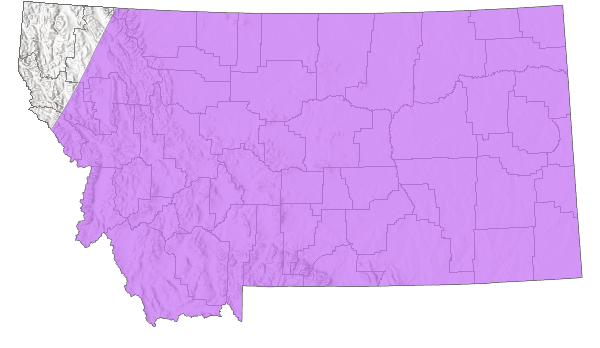
 Native
Native
Range Comments
This is a western grassland species, occurring from the lower latitudes of Alberta, Saskatchewan, and Manitoba, southward to Arizona, New Mexico, and the panhandle of Texas, from Montana, Idaho, and Utah, extending eastward to western Minnesota and Iowa. In Montana, it has been reported for 43 counties (Otte 1984, Vickery and Kevan 1985, Pfadt 2002, Capinera et al. 2004, and Scott 2010).
Observations in Montana Natural Heritage Program Database
Number of Observations: 32
(Click on the following maps and charts to see full sized version)
Map Help and Descriptions
Relative Density
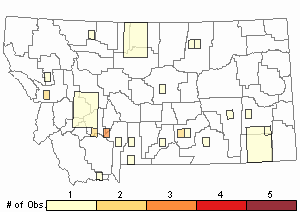
Recency
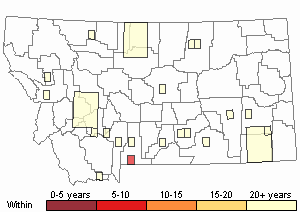
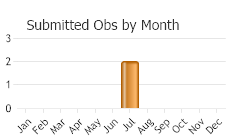
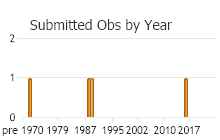
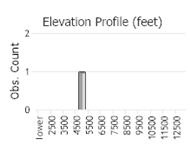 (Observations spanning multiple months or years are excluded from time charts)
(Observations spanning multiple months or years are excluded from time charts)
Habitat
The Blue-legged Grasshopper inhabits shortgrass, mixedgrass, and tallgrass prairies, and mountain meadows. This species reaches its densities in the more northern mixedgrass prairies in areas dominated by western wheatgrass, which generally is a more mesic habitat occurring on clay soil, in valley bottoms, and old dry lake beds (Otte 1984, and Pfadt 2002).
Food Habits
The Blue-legged Grasshopper consumes almost exclusively grasses and sedges, including
Western Wheatgrass (
Elymus smithii) (favored),
Bluebunch Wheatgrass (
Elymus spicatus),
Needle-and-Thread (
Stipa comata),
Green Needlegrass (
Stipa viridula),
Sand Dropseed,
Prairie Junegrass (
Koeleria macrantha),
Blue Gramma (
Bouteloua gracilis) and
Carex sedges. It has also been observed feeding upon green and dry grass litter, dry cattle droppings, and small mat-forming lichens. Sometimes it can damage wheat and other grain crops. Their grass-feeding methods are unusual among the Orthoptera. A hungry adult, crawling across the ground, contacts a food plant, climbs upward, and cuts a 3–4-inch terminal section of the leaf, felling it to the ground. The grasshopper drops to the ground to recover the leaf section, manipulates the section with its front tarsi, and consumes the entire segment. Sometimes, a hungry grasshopper may come upon an attached recumbent grass leaf or one lying on the ground and feed upon it. The 4th and 5th nymphal instars feed in a similar manner or feed on both green and dry leaf litter (Pfadt 2002).
Reproductive Characteristics
To date, observations have not been made of the courting and mating of the Blue-legged Grasshopper. It has been observed, however, that females oviposit in bare ground or ground covered with litter. She deposits her eggs 2 inches deep, in a pod containing 14 eggs, arranged in two to three disorderly columns. The eggs are reddish-brown, measuring 7.3 mm long by 1.3 mm in diameter. When the eggs hatch, the nymphs pass through 5 instar stages to the adult stage, requiring about 36 days.
Stewardship Responsibility
References
- Literature Cited AboveLegend:
 View Online Publication
View Online Publication Brooks, A.R. 1958. Acridoidea of Southern Alberta, Saskatchewan, and Manitoba (Orthoptera). The Canadian Entomologist (Supplement 9) 90:5-92.
Brooks, A.R. 1958. Acridoidea of Southern Alberta, Saskatchewan, and Manitoba (Orthoptera). The Canadian Entomologist (Supplement 9) 90:5-92. Brust, M.L, W.W. Hoback, and R.J. Wright. 2008. The Grasshoppers of Nebraska. Lincoln, NB: University of Nebraska Extension Service, APHIS.
Brust, M.L, W.W. Hoback, and R.J. Wright. 2008. The Grasshoppers of Nebraska. Lincoln, NB: University of Nebraska Extension Service, APHIS. Capinera, J.L. and T.S. Sechrist. 1982. Grasshoppers of Colorado: Identification, Biology, and Management. Fort Collins, CO: Colorado State University Experiment Station, Bulletin 584S. 161 p.
Capinera, J.L. and T.S. Sechrist. 1982. Grasshoppers of Colorado: Identification, Biology, and Management. Fort Collins, CO: Colorado State University Experiment Station, Bulletin 584S. 161 p. Capinera, J.L., R.D. Scott, and T.J. Walker. 2004. Field Guide to Grasshoppers, Katydids, and Crickets of the United States. Ithaca, NY. Cornell University Press.
Capinera, J.L., R.D. Scott, and T.J. Walker. 2004. Field Guide to Grasshoppers, Katydids, and Crickets of the United States. Ithaca, NY. Cornell University Press. Hebard, M. 1928. The Orthoptera of Montana. Proceedings of the Academy of Natural Sciences of Philadelphia, Vol. 80:211-306.
Hebard, M. 1928. The Orthoptera of Montana. Proceedings of the Academy of Natural Sciences of Philadelphia, Vol. 80:211-306. Helfer, J.R. 1971. How to Know the Grasshoppers, Crickets, Cockroaches, and Their Allies. Revised edition (out of print), Mineola, NY: Dover Publications.
Helfer, J.R. 1971. How to Know the Grasshoppers, Crickets, Cockroaches, and Their Allies. Revised edition (out of print), Mineola, NY: Dover Publications. Otte, Daniel. 1984. The North American Grasshoppers Volume II. Acrididae (Oedipodinae). Harvard University Press. 366 pp.
Otte, Daniel. 1984. The North American Grasshoppers Volume II. Acrididae (Oedipodinae). Harvard University Press. 366 pp. Pfadt, R.E. 2002. Field Guide to Common Western Grasshoppers, 3rd edition. Laramie, WY: Wyoming Agricultural Experiment Station, Bulletin 912, modified by S. Schell and S. Schell for electronic publication. Accessed 19 February 2020. http://www.uwyo.edu/entomology/grasshoppers/field-guide/index.html#fieldguidetoc
Pfadt, R.E. 2002. Field Guide to Common Western Grasshoppers, 3rd edition. Laramie, WY: Wyoming Agricultural Experiment Station, Bulletin 912, modified by S. Schell and S. Schell for electronic publication. Accessed 19 February 2020. http://www.uwyo.edu/entomology/grasshoppers/field-guide/index.html#fieldguidetoc Scott, R.D. 2010. Montana Grasshoppers, Katydids, and Crickets A Pictorial Field Guide to the Orthoptera. MagpieMTGraphics, Billings, MT.
Scott, R.D. 2010. Montana Grasshoppers, Katydids, and Crickets A Pictorial Field Guide to the Orthoptera. MagpieMTGraphics, Billings, MT. Vickery, V. R. and D. K. M. Kevan. 1985. The grasshopper, crickets, and related insects of Canada and adjacent regions. Biosystematics Research Institute, Ottawa, Ontario. Publication Number 1777. 918 pp.
Vickery, V. R. and D. K. M. Kevan. 1985. The grasshopper, crickets, and related insects of Canada and adjacent regions. Biosystematics Research Institute, Ottawa, Ontario. Publication Number 1777. 918 pp.
- Additional ReferencesLegend:
 View Online Publication
View Online Publication
Do you know of a citation we're missing? Anderson, N.L. 1951. Field studies on the biology of range grasshoppers of southeastern Montana. M.Sc. Thesis. Bozeman, Montana: Montana State University. 96 p.
Anderson, N.L. 1951. Field studies on the biology of range grasshoppers of southeastern Montana. M.Sc. Thesis. Bozeman, Montana: Montana State University. 96 p. Anderson, N.L. 1962. Grasshopper-vegetation relationships on Montana grasslands. Ph.D Dissertation. Bozeman, Montana: Montana State University. 73 p.
Anderson, N.L. 1962. Grasshopper-vegetation relationships on Montana grasslands. Ph.D Dissertation. Bozeman, Montana: Montana State University. 73 p. Gillespie, R.L.1992. Dynamics of grasshoppers (Orthoptera: Acrididae) at a rangeland-crop interference. Ph.D. Bozeman, MT: Montana State University. 111 p.
Gillespie, R.L.1992. Dynamics of grasshoppers (Orthoptera: Acrididae) at a rangeland-crop interference. Ph.D. Bozeman, MT: Montana State University. 111 p. Henry, J.E. 1969. Protozoan and viral pathogens of grasshoppers. Ph.D. Dissertation. Bozeman, MT: Montana State University. 153 p.
Henry, J.E. 1969. Protozoan and viral pathogens of grasshoppers. Ph.D. Dissertation. Bozeman, MT: Montana State University. 153 p. Mussgnug, G.L. 1972. The structure and performance of an adult population of Aulocara elliotti (Thomas) (Orthoptera, Acrididae) near Billings, Montana. M.Sc. Thesis. Bozeman, MT: Montana State University. 97 p.
Mussgnug, G.L. 1972. The structure and performance of an adult population of Aulocara elliotti (Thomas) (Orthoptera, Acrididae) near Billings, Montana. M.Sc. Thesis. Bozeman, MT: Montana State University. 97 p. Sater, S. 2022. The insects of Sevenmile Creek, a pictorial guide to their diversity and ecology. Undergraduate Thesis. Helena, MT: Carroll College. 242 p.
Sater, S. 2022. The insects of Sevenmile Creek, a pictorial guide to their diversity and ecology. Undergraduate Thesis. Helena, MT: Carroll College. 242 p. Skinner, K.F. 1995. Plant and grasshopper community composition: indicators & interactions across three spatial scales. M.Sc. Thesis. Bozeman, MT: Montana State University. 144 p.
Skinner, K.F. 1995. Plant and grasshopper community composition: indicators & interactions across three spatial scales. M.Sc. Thesis. Bozeman, MT: Montana State University. 144 p.
- Web Search Engines for Articles on "Blue-legged Grasshopper"
- Additional Sources of Information Related to "Insects"





